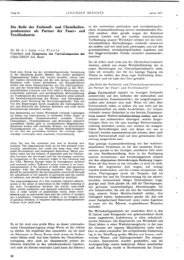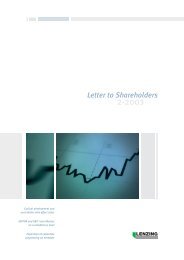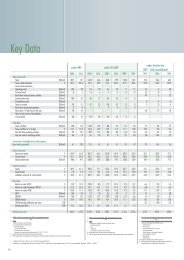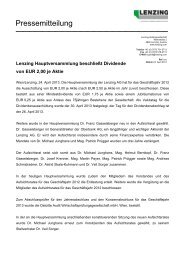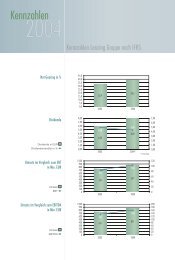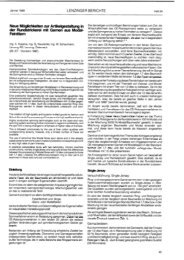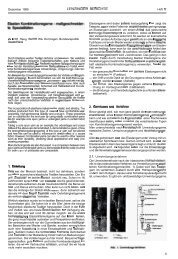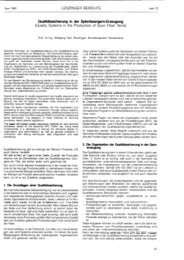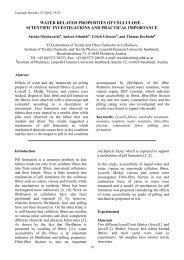THE SORPTION BEHAVIOUR OF CELLULOSE FIBRES - Lenzing
THE SORPTION BEHAVIOUR OF CELLULOSE FIBRES - Lenzing
THE SORPTION BEHAVIOUR OF CELLULOSE FIBRES - Lenzing
Create successful ePaper yourself
Turn your PDF publications into a flip-book with our unique Google optimized e-Paper software.
Abstract<br />
28<br />
<strong>THE</strong> <strong>SORPTION</strong> <strong>BEHAVIOUR</strong> <strong>OF</strong> <strong>CELLULOSE</strong> <strong>FIBRES</strong><br />
Tatjana Kreze, 1 Karin Stana-Kleinschek, 1 Volker Ribitsch 2<br />
1 University of Maribor, Institute of Textile Chemistry,<br />
Laboratory for Characterisation and Processing of Polymers<br />
2 University of Graz, Institute of Chemistry, Rheology & Colloid Science<br />
Cellulose fibres are the most important materials<br />
in textile finishing. Reactivity and adsorption<br />
properties of the fibres are critical<br />
for the success of the treatment. Of major interest<br />
are the properties of fibres swollen in<br />
polar liquids. Under this circumstances the<br />
less ordered regions determine the fibre properties<br />
and therefore the void size and accessible<br />
amorphous regions are supposed to be<br />
responsible for the reactivity.<br />
This work correlates the fine structure, surface<br />
properties with the adsorption behaviour<br />
of the new lyocell fibres [[1]]. The fine structure<br />
was investigated by conventional methods<br />
[[2],[3]] and compared with those of<br />
viscose, modal and differently pre-treated cot-<br />
Deutsche Zusammenfassung<br />
Cellulosefasern sind jene textilen Fasern die am<br />
häufigsten hochveredelt werden. Die Reaktivität<br />
und das Adsorptionsverhalten der Fasern ist für<br />
diese Bearbeitung von größte Bedeutung. Von<br />
besonderem Interesse ist das Verhalten der gequollenen<br />
Fasern in polaren Medien, wo in erste<br />
Linie die Eigenschaften der ungeordneten Bereiche<br />
eine wichtige Rolle spielen. Es wird angenommen,<br />
dass in diesem Zustand die Reaktivität<br />
der Faser überwiegend auf ihre Porengröße und<br />
die zugänglichen amorphen Bereiche zurückzuführen<br />
ist .<br />
In der vorliegenden Arbeit wird eine Korrelation<br />
zwischen der Feinstruktur, den Oberflächeneigenschaften<br />
und dem Adsorptionsvermögen der<br />
neuen Lyocellfasern hergestellt [[1]]. Die Feinstruktur<br />
der Lyocellfaser wurde mit klassischen<br />
Methoden untersucht [[2],[3]] und mit jener von<br />
Viskose, Modal und unterschiedlich vorbehandelter<br />
Baumwollfasern verglichen. Das Adsorp-<br />
_______________________________________<br />
ton. The adsorption properties of all kinds of<br />
fibres were investigated by water adsorption<br />
(vapour adsorption, water retention, swelling<br />
of fibres). Due to the fact that the interaction<br />
properties are strongly influenced by the electric<br />
charges on the surface, the streaming potential<br />
was measured and from this values the<br />
zetapotential was calculated as a function of<br />
the pH.<br />
Our results, obtained by different independent<br />
methods, demonstrate clearly, that the<br />
adsorption properties of fibre forming polymers<br />
are determined by the amorphous regions,<br />
the size and organisation of voids and<br />
the interaction properties of the surface. The<br />
influence of the crystalline regions, their size<br />
and orientation on the adsorption character is<br />
less important.<br />
tionsverhalten wurden mittels Wasserdampfadsorption,<br />
Wasserrückhaltevermögen und Quellung<br />
in wässrigen Medium bestimmt. Da die<br />
Wechselwirkungen zwischen den Fasern und den<br />
Prozesschemikalien auch wesentlich von den<br />
Ladungseigenschaften der Oberfläche (elektrokinetische<br />
Eigenschaften, Oberflächenpotential)<br />
der Fasern abhängt, wurden diese mittels Strömungspotentialmessung<br />
bestimmt und daraus das<br />
Zetapotential als Funktion des pH – Wertes berechnet.<br />
Unsere Resultate, die mit unabhängigen Methoden<br />
gewonnen wurden, zeigen, dass das Adsorptionsverhalten<br />
faserformiger Polymerer in erster<br />
Linie von den amorphen Bereichen, der Zusammensetzung<br />
und Organisation der Hohlräume<br />
und den Wechselwirkungs-eigenschaften der<br />
Faseroberfläche bestimmt wird. Der Einfluss der<br />
kristallinen Bereiche, deren Größe und Orientierungsgrad<br />
auf das Adsorptionsverhalten ist geringer.<br />
28
Introduction<br />
Conventional regenerated cellulose fibres are<br />
produced generally by the indirect viscose process<br />
(viscose fibres), while high-tenacity modal<br />
fibres are produced using a modification of the<br />
basic procedure. The fibre production processes<br />
are based on the derivatisation of cellulose using<br />
carbon disulfide [[4],[5]]. New lyocell fibres are<br />
produced by a more environmentally friendly<br />
procedure, by regenerating cellulose into fibre<br />
form out of a solution of cellulose in Nmethylmorpholine-N-oxide,<br />
without the formation<br />
of derivatives [[6],[7],[8],[9],[10]]. The<br />
natural, as well as the conventional and new regenerated<br />
cellulose fibres, consist more or less of<br />
a chemically clean cellulose. The natural fibres<br />
are always cleaned in order to remove the noncellulose<br />
compounds (as pectinic products, wax,<br />
proteins…). Different production processes of<br />
conventional viscose, modal, and new lyocell<br />
fibres cause differences in the structure and<br />
properties of the fibres in spite of having the<br />
same chemical composition.<br />
Cellulose fibres, natural as well as regenerated,<br />
have a crystalline/amorphous microfibrillar<br />
structure. Elementary fibrils consist of a succession<br />
of crystallites and intermediate less-ordered<br />
amorphous regions. Lateral tie molecules connect<br />
laterally adjacent amorphous regions<br />
[[11],[12]]. The differences between natural and<br />
particular types of regenerated cellulose fibres<br />
are, above all, in the size of crystallites and<br />
amorphous regions, amorphous and crystalline<br />
orientation, size and shape of the voids and the<br />
number of interfibrillar lateral tie molecules. In<br />
order to characterise cellulose accessibility, interaction<br />
with water is often employed, which is<br />
able to destroy weaker hydrogen bonds but cannot<br />
penetrate into the regions of high order<br />
[[13],[14]]). The adsorption properties of fibres<br />
can be obtained also on the basis of various<br />
methods for determining the dye, iodine, surfactant<br />
adsorption [[13],[15]]. Currently some additional<br />
methods especially sensitive to surface<br />
properties (determination of the electrokinetic<br />
properties of fibres) were applied in order to<br />
characterize the reactivity of the fibre surfaces<br />
[[16],[17]].<br />
Analyses of the structure characteristics of new<br />
lyocell fibres and comparison with conventional<br />
viscose and modal fibres were performed. The<br />
29<br />
degree of polymerisation DP and the supermolecular<br />
structure (crystallinity index CrI, crystallite<br />
dimension Λ*, molecular orientation f∆n, void<br />
structure Vp, Sp, d) of the regenerated cellulose<br />
fibres were investigated [[2],[3]]. Differences in<br />
molecular and supramolecular structure of natural<br />
and different types of regenerated cellulose<br />
fibres cause different adsorption and electrokinetical<br />
properties of fibres. In addition the structural<br />
parameters (amorphous regions and void<br />
system) which significantly influence the adsorption<br />
properties of fibres (moisture adsorption,<br />
water retention, swelling of fibres in aqueous<br />
medium) were determined. The accessibility of<br />
free adsorption places in the amorphous part of<br />
cellulose fibres was investigated by the determination<br />
of electrokinetic properties, which were<br />
analysed by zeta potential (ζ) measurements.<br />
Experimental<br />
Materials. Three types of the regenerated cellulose<br />
fibres (viscose, modal, lyocell) and one of the natural<br />
cellulose fibres (100% cotton fabric; purified and<br />
NaOH mercerised), produced by <strong>Lenzing</strong> AG Austria,<br />
were investigated. In previous research work the<br />
analysis of structural parameters (molecular mass,<br />
degree of polymerisation, crystallinity index, orientation<br />
factor, void structure) and mechanical properties<br />
of investigated regenerated cellulose fibres was performed<br />
[[2],[3]]. In Table 1 and Table 2 the specifications<br />
and some of the most important 7fibre structure<br />
characteristics of investigated cellulose fibres were<br />
presented.<br />
The following surface and structure modification<br />
processes for the cotton cellulose fibres were applied:<br />
a) - Purifying treatment (the cellulose structure remains<br />
unchanged - cellulose I); symbolized as –<br />
Cotton 2%NaOH<br />
- Boiling - Removal of non-cellulose compounds -<br />
interfibrillar swelling: (20 g/l NaOH; pH = 11.5;<br />
t = 90 min; T = 95°C).<br />
b) - Treatment causing a structural modifications<br />
(the cellulose structure is changed to cellulose<br />
II); symbolized as – Cotton 24%NaOH<br />
- Mercerisation - interfibrillar and intrafibrillar<br />
swelling: (24% NaOH, pH = 13, t = 60s, T =<br />
15°C)<br />
After each treatment the fibres were washed with<br />
distilled water until a conductivity of less than 3<br />
ms/m was reached. The processed material was airdried.<br />
29
Table 1. Specifications and structure characteristics of regenerated cellulose fibres [1]], [2].<br />
Fibre type Viscose Modal Lyocell<br />
Symbol CV CMD CLY<br />
Linear density Tt [dtex] DIN 53 812 1.88 ±0.15 1.78 ±0.23 1.82 ±0.30<br />
Fibre length l [mm] DIN 53 808 39.9 ±0.51 40.1 ±0.33 39.4 ±0.44<br />
Fibre diameter d [µm] DIN 53 811 14.3 ±1.39 14.2 ±1.10 12.8 ±1.00<br />
Density ρ [g/cm 3 ] DIN 53 479 1.5045 1.5141 1.5205<br />
Degree of polymerisation DP DIN 54 270 235 ±5.13 507 ±3.61 642 ±4.58<br />
Molecular mass M DIN 54 270 38005 ±881 82097 ±538 104021 ±730<br />
Crystallinity index CrI * 0.25 0.37 0.44<br />
Orientation factor f ∆n ** 0.58 ±0.07 0.69 ±0.08 0.71 ±0.04<br />
Void volume Vp [cm 3 /g] *** 0.68 0.49 0.62<br />
30<br />
* Determined by X-ray wide angle diffraction (2θ = 5° - 45°)<br />
** From birefringence measurements of the fibres<br />
*** Determined by size exclusion chromatography [[18],[19],[20],[21]]<br />
Table 2: The specifications of investigated<br />
natural cellulose fibres.<br />
Fibre type Cotton<br />
Symbol Co<br />
Degree of polymerisation DPη<br />
Metal content [ppm/0.5 g fibres]<br />
4700±34.3<br />
Mg<br />
249<br />
Fe<br />
39.4<br />
Mn<br />
1.26<br />
Zn<br />
20.2<br />
Methods. Moisture sorption of fibres was determined<br />
according to standard DIN 54 351. Cellulose<br />
fibres were exposed to standard atmosphere<br />
20 ±2°C, 65% ±2% RH for 24 hours (DIN 53<br />
802). Moisture sorption was calculated as a mass<br />
% of absolute dry material (T = 105°C, t = 4<br />
hours).<br />
Water retention power of cellulose fibres was<br />
determined according to standard DIN 53 814.<br />
This method is based on a determination of the<br />
quantity of water, which the fibres can absorb<br />
and retain under strictly controlled conditions.<br />
This property is expressed as a ratio between the<br />
mass of water retained in the fibre after soaking<br />
(2 hours) and centrifuging (20 min), and the<br />
mass of absolute dry sample (T = 105°C, t = 4<br />
hours).<br />
Swelling of the cellulose fibres in the aqueous<br />
medium was determined on the basis of fibre<br />
diameter measurements. Applied equipment:<br />
fibre diameter measurements were carried out<br />
with the Axiotech 25 HD microscope using the<br />
image analysis system and supporting Kontron<br />
KS 300 software.<br />
Electrokinetic properties of fibres were analysed<br />
by zeta potential ζ measurements, which were<br />
determined by streaming potential measurements<br />
as a function of the pH. It has been shown that<br />
the streaming potential measurement is the most<br />
appropriate electrokinetic technique for studying<br />
electrokinetic properties i.e. the zeta potential (ζ)<br />
of fibres systems [[16],[17]]. The ζ was calculated<br />
from the streaming potential (Us) data using<br />
the Smoluchowski equation. The channel′s<br />
geometry was taken into account according to<br />
Fairbrother and Mastin [[22]]. This measurements<br />
were always performed in a fibre cell using<br />
0.001 n KCl as electrolyte solution. The pH<br />
of the electrolyte solution was always varied in<br />
an identical way. It was first adjusted to pH 10<br />
using 0.1 n NaOH and then decreased gradually<br />
with 0.1 n HCl. The here mentioned zeta potential<br />
values were always those obtained at the<br />
constant part of the zeta potential - pH function<br />
in the alkaline region at pH = 9. Applied equipment:<br />
Electrokinetic Analyzer EKA, A. Paar KG.
Results and discussion<br />
From previous research work [[2]] it is clear that<br />
the crystal structure of the new environmentally<br />
friendly fibers differs from conventional (viscose<br />
or modal) fibers. The structure analyses of investigated<br />
regenerated cellulose fibers (Table 1)<br />
show the following: the molecular mass, degree<br />
of polymerization, density, orientation factor,<br />
crystallinity index decreases from lyocell to modal<br />
fibers. The most significant decrease of these<br />
parameters is evident in the case of viscose fibers.<br />
The same trend is not observed in the case<br />
of the void structure. The analyses of voids using<br />
the size exclusion chromatography show that<br />
voids diameter d, volume Vp and specific inner<br />
surface of voids Sp is the biggest in viscose fibers.<br />
Lyocell fibers follow, they are very similar<br />
to viscose fibers regarding the structure of the<br />
voids. The void volume is the smallest of the<br />
most stretched modal fibers (Table 1).<br />
All three types of investigated fibers differ regarding<br />
their crystalline area (A), amorphous<br />
area (B) and also in the void structure (C) (Figure<br />
1). The amorphous regions of lyocell fibers<br />
are smaller in comparison with modal and viscose<br />
fibers. Nevertheless the void parameters,<br />
above all, the void volume, is similar to that of<br />
viscose fibers. This differences in molecular and<br />
fine structure cause different sorption properties.<br />
It becomes evident that the most significant influence<br />
on the adsorption properties of fibers<br />
have the accessible regions (Figure 1) - the part<br />
of less ordered amorphous regions and void system.<br />
B<br />
A<br />
C<br />
a) b) c)<br />
Figure 1. Accessible regions (A – crystallites,<br />
B – amorphous region, C - void) in fiber structure<br />
of different regenerated cellulose fibers;<br />
a) viscose fibers, b) modal fibers, c) lyocell<br />
fibers [1].<br />
31<br />
[%]<br />
18,0<br />
16,0<br />
14,0<br />
12,0<br />
10,0<br />
8,0<br />
6,0<br />
4,0<br />
Cotton<br />
2%NaOH<br />
Water Vapour Sorption<br />
(at 65% R.H. and T 20°C)<br />
Cotton<br />
24%NaOH<br />
Viscose Lyocell Modal<br />
Figure 2: Water vapour adsorption of different<br />
cellulose fibres.<br />
[%]<br />
105,0<br />
90,0<br />
75,0<br />
60,0<br />
45,0<br />
30,0<br />
15,0<br />
0,0<br />
Cotton<br />
2%NaOH<br />
Water Retention Value<br />
Cotton<br />
24%NaOH<br />
Viscose Lyocell Modal<br />
Figure 3: Water retention power adsorption<br />
of different cellulose fibres.<br />
[%]<br />
45,0<br />
40,0<br />
35,0<br />
30,0<br />
25,0<br />
20,0<br />
15,0<br />
10,0<br />
5,0<br />
0,0<br />
Swelling in aqueous medium<br />
Viscose Lyocell Modal<br />
Figure 4: Swelling of regenerated cellulose<br />
fibres in aqueous medium.<br />
In the Figure 2, 3 and 4 the results of water sorption<br />
measurements: water vapour adsorption,<br />
water retention power and swelling of fibres in<br />
aqueous medium are presented. Water vapour<br />
adsorption shows that the differences between<br />
the investigated fibres are insignificant (modal<br />
31
14.1%, lyocell 14.6%, viscose 15.1%). Viscose<br />
fibres show the highest water retention value,<br />
lyocell fibres follow. Water retention value of<br />
modal fibres is 15% lower then that of lyocell<br />
fibres and 32% lower then that of viscose fibres.<br />
As shown by the data in Figure 4, the increase in<br />
fibre width after swelling in water is also decreases<br />
from viscose fibres (36.3%) to lyocell<br />
fibres (22.0%) and is considerably smaller in the<br />
case of modal fibres (17.4%). The lowest value<br />
of water adsorption have the natural cellulose<br />
fibres (cotton), whose hydrophilic character increases<br />
from cotton NaOH cleaned to cotton<br />
mercerised.<br />
When considering water sorption, the new lyocell<br />
fibres are similar to the less dense, low crystalline<br />
and least oriented viscose fibres. Water<br />
vapour adsorption, water retention, swelling in<br />
water places lyocell fibres between the viscose<br />
and modal fibres. Contrary to expectations the<br />
sorption phenomena in the aqueous medium are<br />
not in agreement with the basic structural data<br />
i.e. degree of crystallinity and orientation factor<br />
(Table 1). In the case of cellulose fibres the<br />
structure of voids (especially their diameter and<br />
volume, and less inner surface) the fraction and<br />
orientation of amorphous areas are more important<br />
than other structural characteristics. The<br />
ordered regions (crystalline) do not contribute<br />
significantly to the process of water adsorption.<br />
In spite of the highest degree of crystallinity and<br />
orientation, lyocell fibers have excellent sorption<br />
properties, similar to those of viscose fibers due<br />
to their void system and amorphous region.<br />
ζ [mV]<br />
0<br />
-2<br />
-4<br />
-6<br />
-8<br />
-10<br />
-12<br />
-14<br />
-16<br />
Cotton 2% NaOH<br />
Cotton 24% NaOH<br />
Viscose<br />
Lyocell<br />
Modal<br />
2 4 6 8 10<br />
pH<br />
Figure 5. Zeta potential ζ as a function of the<br />
pH (conc. of electrolyte solution (KCl) = 0,001<br />
mol/l).<br />
32<br />
Differences are also observed regarding the zeta<br />
potential - pH functions (Figure 5), between the<br />
very hydrophilic regenerated and more crystalline<br />
cotton materials. The hydrophobic character<br />
of cotton in comparison to the hydrophilic character<br />
of regenerated fibres, is responsible for<br />
their highest negative surface charge. The highest<br />
negative zeta potential in the alkaline region,<br />
has boiled cotton fibres (ζplateau of Cotton<br />
2%NaOH = app. – 16 mV). The primary wall of<br />
cotton (location of non-cellulose compounds) at<br />
the fibre surfaces is destroyed using NaOH<br />
cleaning, causing higher accessibility of the surface<br />
groups (COOH). If cotton fibres are mercerised<br />
a decrease of ζplateau is observed, because of<br />
changed cellulose structure. The transformation<br />
of cellulose fine structure from cell I to cell II<br />
causes enlargement of the amorphous part of the<br />
fibre, which leads to the higher reactivity of the<br />
cellulose. The ζplateau values of structured cotton<br />
fibres become similar to those of the regenerated<br />
ones (ζplateau of Cotton 24%NaOH = app –10<br />
mV). The degree of swelling is increased by decreased<br />
crystallinity (the crystallinity of Cotton<br />
24%NaOH is reduced from 90% to 77%; according<br />
to iodine adsorption values ([23]). This is an<br />
explanation for the reduction of the ζplateau .<br />
The ζplateau value of modal is app. –9.5 mV, the ζ<br />
plateau of viscose is the smallest (app. –5 mV),<br />
probably due to the distinct reactive groups (OH<br />
and COOH) accessibility, which is determined<br />
by different structure of regenerated fibres ([1],<br />
[2]).<br />
Conclusion<br />
The results of the vapour adsorption, water retention<br />
power and swelling of different cellulose<br />
fibres show clear differences between the hydrophilic<br />
(viscos, lyocell) and the hydrophobic fibres<br />
(cotton, cotton-mercerised) which are in<br />
excellent correlation with the – pH function of<br />
cellulose fibres.<br />
The results of fibre reactivity and adsorption<br />
characteristics obtained by conventional methods,<br />
correlate with the electrokinetic character of<br />
materials – the natural fibres are less reactive as<br />
the regenerated one, so the ζmax of cotton is the<br />
highest. The hydrophilicity of cotton is improved<br />
by mercerisation (changed primary structureformation<br />
of cell II structure), but not as high as<br />
32
in the case of viscose and lyocell fibres. The surface<br />
potential is in the good correlation with fibre<br />
behaviour in polar liquids (in the swollen state) –<br />
the higher the potential the smaller the hydrophilic<br />
character of the material.<br />
References<br />
[1] T.Kreze, Dissertation, University of Maribor,<br />
(1999).<br />
[2] T. Kreze, S. Strnad, K. Stana-Kleinschek,<br />
V. Ribitsch, Materials Research Innovations,<br />
4 (2001) 2/3, 107-114.<br />
[3] T.Kreze, S.Malej, Textile Research Journal,<br />
in press.<br />
[4] G.Cook, Handbook of textile Fibres, Man-<br />
Made Fibres, 5 th ed., Merrow, Durham,<br />
(1984), 47-64.<br />
[5] R.W.Moncrieff, Man-Made Fibres, Sixth<br />
Edition, Butterworths Scientific, London<br />
(1975).<br />
[6] W.Albrecht, M.Reintjes, B.Wulfhorst,<br />
Chem. Fibres International 47, (1997),<br />
289-304.<br />
[7] W.Berger, Chemiefasern / Textilindustrie<br />
44/96, (1994), 747-750.<br />
[8] H.Brüger, Chemiefasern / Textilindustrie,<br />
44/96, (1994), 701.<br />
[9] D.J.Cole, <strong>Lenzing</strong>er Berichte 75, (1996),<br />
45-48.<br />
[10] R.Krüger, <strong>Lenzing</strong>er Berichte 74, (1994),<br />
49-52.<br />
33<br />
[11] J.Schurz, <strong>Lenzing</strong>er Berichte 74, (1994),<br />
37-40.<br />
[12] J.Schurz, J.Lenz, Macromol. Symp. 83,<br />
(1994), 273-289.<br />
[13] D. Klemm, personal communication.<br />
[14] M.Peter, H.K.Rouette, Grundlgen der Textilveredlung,<br />
13. Auflage, Deutscher Fachverlag,<br />
Frankfurt, (1989).<br />
[15] M.Lewin, S.B.Sello, Chemical Processing<br />
of Fibers and Fabrics, Part A Fundamentals<br />
and preparation, Marcel Deckker, Inc.,<br />
New York and Basel, (1983).<br />
[16] K.Stana-Kleinschek, S.Strnad, V.Ribitsch,<br />
Polymer Enginnering & Science 39, No.8<br />
(1999) 1412-1424.<br />
[17] K.Stana-Kleinschek, S.Strnad, V.Ribitsch,<br />
Colloids and Surfaces A 140, (1998), 127-<br />
138.<br />
[18] K.Bredereck, M.Gruber, A.Otterbach,<br />
F.Schulz, Textilveredlung 31, Nr.9/10,<br />
(1996), 194-200.<br />
[19] K.Bredereck, F.Schulz, A.Otterbach, Melliand<br />
Textilberichte 10, (1997), 703-711.<br />
[20] K.Bredereck, W.Meister, A.Blüher, Melliand<br />
Textilberichte 12, (1993), 1271-1276.<br />
[21] K.Bredereck, A.Blüher, A.Hoffmann-Frey,<br />
Das Papier 44, Heft 12 (1990), 648-656.<br />
[22] F.Fairbrother, H.Mastin, J. Chem. Soc.<br />
(1924) 75, 2318.<br />
[23] K.Stana-Kleinschek, T.Kreze, V.Ribitsch,<br />
S.Strnad, Mac. Materials and Engineering,<br />
in press.<br />
33



